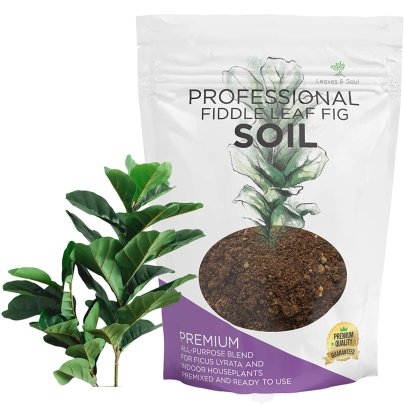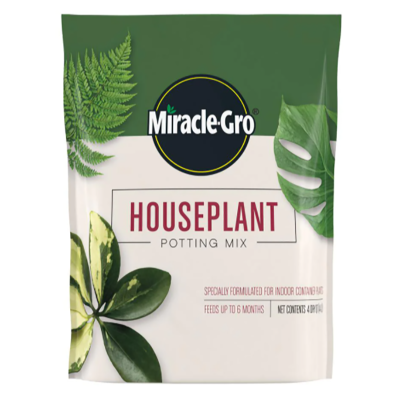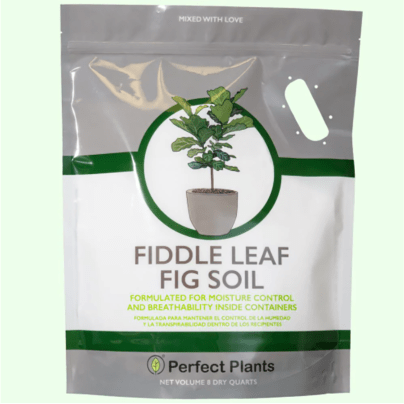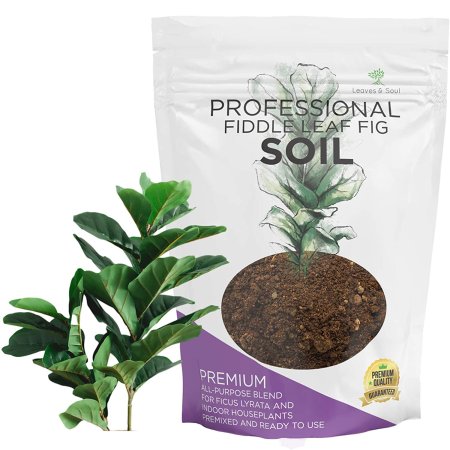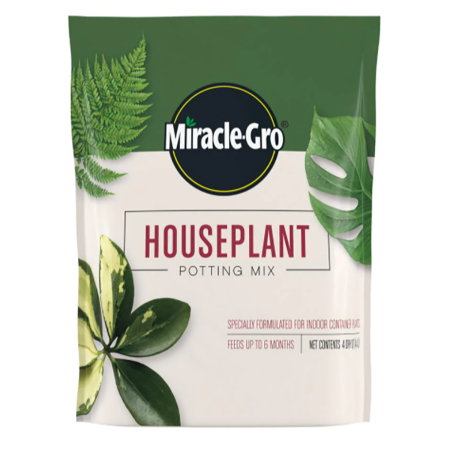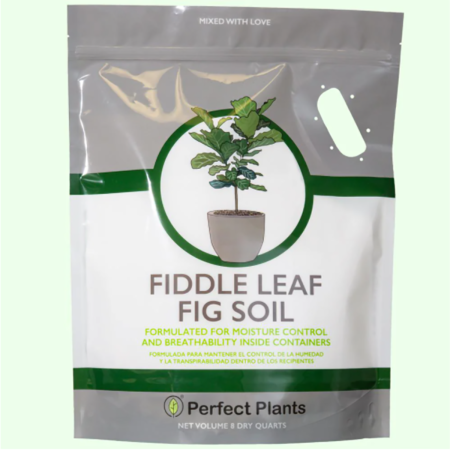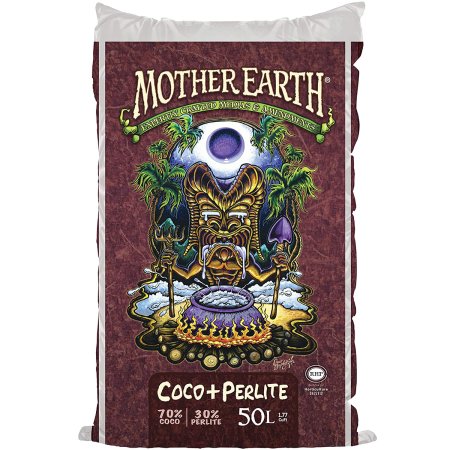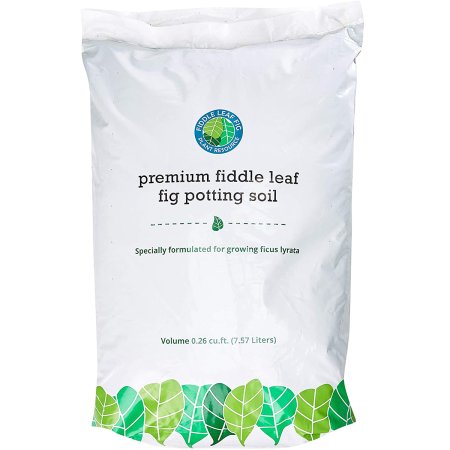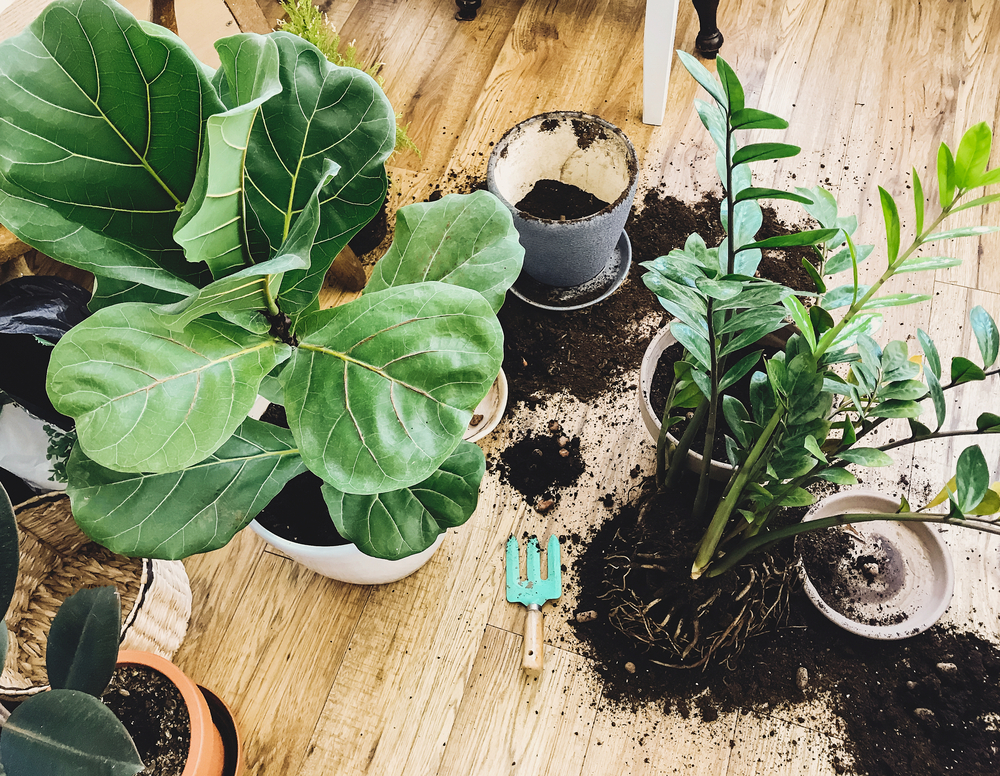
We may earn revenue from the products available on this page and participate in affiliate programs. Learn More ›
The fast-growing and exotic fiddle leaf fig (Ficus lyrata) isn’t a picky plant, but soil for fiddle leaf figs should drain quickly to prevent roots from standing in water. Optimal soil drains well yet retains a modicum of moisture to keep the roots from drying out completely.
Good soil can help these plants stretch up to 10 feet tall, and some excellent growing mixes are available. We like Leaves and Soul Fiddle Leaf Fig House Plan Soil for its draining properties and sturdy structure. But that’s not the only product we like.
Keep reading to learn more about our top picks for these towering houseplants and what to look for when choosing the best soil for fiddle leaf figs.
- BEST OVERALL: Leaves and Soul Fiddle Leaf Fig House Plant Soil
- BEST BANG FOR THE BUCK: Miracle-Gro Indoor Houseplant Potting Mix
- BEST MOISTURE CONTROL: Perfect Plants Fiddle Leaf Fig Soil Mix
- BEST FOR AERATION: Mother Earth Coco Plus Perlite Mix
- BEST ECO-CONSCIOUS: Fiddle Leaf Fig Plant Food Potting Soil

Fiddle Leaf Fig Soil Comparison
| Product | Primary Ingredients | Made specifically for fiddle leaf figs? | Product Size |
| Leaves and Soul Fiddle Leaf Fig House Plant Soil | Pine bark, sawdust, sand, moss | ✅ | 2.2 quarts |
| Miracle-Gro Indoor Houseplant Potting Mix | Sphagnum peat moss, coconut coir, perlite | ❌ | 4 quarts |
| Perfect Plants Fiddle Leaf Fig Soil Mix | Bark, perlite, coir, sand | ✅ | 8 quarts |
| Mother Earth Coco Plus Perlite Mix | Coconut coir, perlite | ❌ | 50 liters |
| Fiddle Leaf Fig Plant Food Potting Soil | Aged bark, wood biochar, coco coir, green compost | ✅ | 7.57 liters |
Our Top Picks
As top picks, the following potting soils are suitable for a fiddle leaf fig’s growing and nutritional needs. Some are considered all-purpose indoor grow mixes, but they contain the ingredients necessary to ensure thorough drainage and moisture retention. Any one of the following mixes helps provide a healthy foundation for the fiddle leaf fig.
Best Overall
Leaves and Soul Fiddle Leaf Fig House Plant Soil
What We Like
- Drains well
- Moisture retentive
- Offers structural support
What We Don’t Like
- Multiple bags necessary for large plants
Product Specs
- Primary ingredients: Pine bark, sawdust, sand, moss
- Made specifically for fiddle leaf figs? Yes
- Product size: 2.2 quarts
Containing a combination of pine bark, sawdust, coarse sand, and sphagnum peat moss, this potting mix made by Leaves and Soul provides an optimal environment for growing fiddle leaf fig plants. The pine bark chips are ⅜ inch in size to help create air pockets in the soil and promote drainage. Moreover, the peat moss helps add lightness to the mixture while retaining moisture and gradually releasing it.
The addition of sand creates stability in the soil. Fiddle leaf figs need a heavy substance to anchor their roots to prevent them from toppling over. This premium blend offers an ideal combination of drainage and aeration to keep fiddle leaf figs healthy and free of disease.
Get the Leaves and Soul soil at Amazon.
Best Bang For the Buck
Miracle-Gro Indoor Houseplant Potting Mix
What We Like
- Drains well
- Retains moisture
- Fights gnats
- Affordable
What We Don’t Like
- No additional structural ingredients
Product Specs
- Primary ingredients: Sphagnum peat moss, coconut coir, perlite
- Made specifically for fiddle leaf figs? No
- Product size: 4 quarts
It doesn’t take a lot of money to find the best soil for indoor fiddle leaf fig. Miracle-Gro, a nationally known manufacturer of quality gardening products, provides a well-draining indoor soil mix that contains a small amount of fertilizer to boost the plant’s health and growth.
While this product is designed for growing many types of houseplants, it’s also suitable for fiddle leaf fig. Its combination of sphagnum peat moss, coconut coir, and perlite encourage drainage while retaining moisture. This potting soil is suitable for growing smaller fiddle leaf figs—up to 4 to 5 feet in height. It doesn’t provide additional structural support; however, it can be mixed with sand or gravel for larger specimens.
Get the Miracle-Gro soil at Amazon or Walmart.
Best Moisture Control
Perfect Plants Fiddle Leaf Fig Soil Mix
What We Like
- Drains well
- Retains moisture
- Provides structural support
- Fertilizer included
What We Don’t Like
- Not available in bags smaller than 8 quarts
Product Specs
- Primary ingredients: Bark, perlite, coir, sand
- Made specifically for fiddle leaf figs? Yes
- Product size: 8 quarts
This potting mix by Perfect Plants contains pine bark, perlite, coconut coir, sand, and a small amount of fertilizer, so no additional fertilizer is necessary for at least 6 months.
The sand and pine bark allow water to run right through, while the peat moss adds lightness, absorbs moisture, and releases it slowly. The sand also adds structural integrity to the mix, so it’s suitable for planting large fiddle leaf figs that are more than 6 feet high.
Get the Perfect Plants soil at Amazon.
Best For Aeration
Mother Earth Coco Plus Perlite Mix
What We Like
- Drains well
- Optimal aeration
- Good for repotting fiddle leaf figs
What We Don’t Like
- No additional structural ingredients
Product Specs
- Primary ingredients: Coconut coir, perlite
- Made specifically for fiddle leaf figs? No
- Product size: 50 liters
The high percentage of coconut coir (70 percent) in this premium potting soil provides the optimal aeration needed by fiddle leaf fig roots. Perlite, the other main ingredient in this Mother Earth mix, helps retain moisture and keep the mixture light and aerated to prevent overwatering or poor drainage.
This lightweight mix can be used to repot young fiddle leaf fig plants, but it doesn’t provide the structural integrity required for larger specimens. Combine it with sand or gravel to add additional support when repotting mature fiddle leaf figs. The mix is suitable for repotting plants showing the first signs of overwatering, such as brown spots or limp leaves.
Get the Mother Earth soil at Amazon.
Best Eco-Conscious
Fiddle Leaf Fig Plant Food Potting Soil
What We Like
- Sustainably sourced ingredients
- Drains well
- Retains moisture
- Promotes root health
What We Don’t Like
- No added structural ingredients
Product Specs
- Primary ingredients: Aged bark, wood biochar, coco coir, green compost
- Made specifically for fiddle leaf figs? Yes
- Product size: 7.57 liters
Certified safe and nontoxic, this Fiddle Leaf Fig Plant Food premium blend of potting soil combines high-quality, sustainably sourced ingredients designed specifically for growing fiddle leaf figs. Even the packaging is made from recycled materials.
Ingredients include coco coir, wood biochar (a charcoal product), aged bark, and green compost, which, when combined, offer a well-draining soil that retains moisture, making it a top choice for growing a fiddle leaf fig. This plant-specific growing mix is produced using eco-friendly processes. The inclusion of biochar helps the plant retain essential nutrients, such as nitrogen and phosphorus, and the combination protects fiddle leaf figs from both overwatering and underwatering.
Get the Fiddle Leaf Fig Plant soil at Amazon.
How We Chose the Best Soil for Fiddle Leaf Figs
In our quest to find some of the best soil options for growing fiddle leaf figs, we extensively researched dozens of indoor potting soil products. Some fiddle leaf fig planting soil blends are labeled specifically for fiddle leaf fig plants. Others are designed for all-around growing purposes but contain the components necessary for healthy fiddle leaf fig growth. We considered brand reputation, sustainable production methods, and price, but ultimately, our choices came down to the most suitable products for growing this stunning houseplant specimen.
What to Consider When Buying Soil for a Fiddle Leaf Fig
The fiddle leaf fig prefers a soil mix that won’t compress or pack down but still has enough structural integrity to anchor the plant’s roots firmly. If the mix is too light, it can tip to the side as the plant gets taller, and its root ball can pull out of the soil. If the soil is too heavy, it can become dense. The dense soil can keep air from getting to the roots, which can stunt the plant’s growth or prevent water from draining, resulting in root rot.
Types of Soil for Fiddle Leaf Figs
Several all-purpose potting mixes designed for growing indoor houseplants may be suitable for growing this plant. However, the best soil mix for fiddle leaf fig is often a growing mix designed specifically for the plant. Avoid planting it in garden soil, which is typically too dense.
While plant-specific mixes are similar in structure to all-purpose blends, they’ve been tweaked for the specific needs of the fiddle leaf fig. The best soil for indoor fiddle leaf fig plants likely contains one or more of the following:
- Bark: Chunks of fir or pine bark help prevent the mixture from compacting and encourage drainage.
- Moss: Sphagnum peat moss serves two purposes: It drains well but also absorbs water and releases it slowly, so roots don’t dry out.
- Perlite: A lightweight byproduct of volcanic glass, perlite helps create air pockets in the soil so oxygen can reach the roots. It also retains water to keep the soil slightly moist.
- Coconut coir: A fibrous layer between the fruit of the coconut and its outer shell, coconut coir helps keep the growing mix light and airy. It also absorbs water and releases it slowly.
- Charcoal: A product of charred wood or peat, charcoal absorbs salts and impurities in the soil while adding to the soil’s structure to help support fiddle leaf fig roots.
- Sand: Coarse sand offers stability in a potting mix, and it encourages drainage.
Drainage
The most important consideration when choosing soil for fiddle leaf fig plants is to use a soil that drains well. This plant does not like ”wet feet.” If its roots stand in water, it may experience root rot. Poor soil drainage can cause drooping leaves or brown spots on them. If the leaves begin to drop, the plant may have root rot, and it may be too late to save it. The earlier that poor drainage is detected and the plant is repotted, the better the chance of saving it.
When watering the plant, look for water to run out from the drainage holes in the bottom of the pot. Good-draining soil permits most of the water to run through, yet some is absorbed and retained to create a slightly moist environment.
Water Retention
Although it may seem counterintuitive for a soil to both drain well and still retain water, that’s the optimal combination for a fiddle leaf fig. Ingredients such as sand and large chunks of bark create air spaces in the mix and help promote drainage. Other components, such as peat moss, absorb some of the water and then release it slowly. Still other ingredients, such as coco coir and perlite, perform both functions.
In addition, some manufacturers may add small clay pellets that absorb water and then release it slowly. This is beneficial when growing larger fiddle leaf figs, and it can help anchor the roots firmly in the pot.
The pH Level
Fiddle leaf figs prefer soil with a near-neutral acid/alkaline balance between 5.3 and 6.7 on the pH scale, close to their native growing environment. A pH level lower than 5.3 may be too acidic and result in limp, yellowing leaves. On the other hand, a pH over 6.7 may be too alkaline, and the plant may develop red spots on the leaves and fail to grow.
Rather than trying to correct existing fiddle leaf fig soil with a pH that’s too high or too low, it’s better to repot the plant in new soil that’s better suited to its needs. If pH is a concern, inexpensive pH test kits are available for testing soil alkalinity and acidity.
FAQs
Q. Can I use succulent soil for fiddle leaf figs?
In some cases, yes, but opt for a mix that contains less than 50 percent sand as well as ingredients that provide a measure of moisture retention.
Q. How do you mix potting soil for a fiddle leaf fig?
A commercial product that drains well and retains moisture is usually better than a DIY soil, but a ratio of ⅓ perlite to ⅔ peat-type ingredients is suitable. For large fiddle leaf figs, consider adding a small amount of sand or gravel to help provide some structural integrity.
Q. Are coffee grounds good for fiddle leaf figs?
No. Coffee grounds can result in too much moisture retention, reducing drainage and increasing the risk of fungal diseases and gnat infestations.
Q. How long can fiddle leaf figs go without water?
When planted in optimal soil, fiddle leaf figs can do OK for up to 10 days between waterings.
Q. What does an overwatered fiddle leaf fig look like?
Too much water is the biggest enemy of the plant, and it can result in brown spots on the leaves, limp leaves, or dropped leaves.
